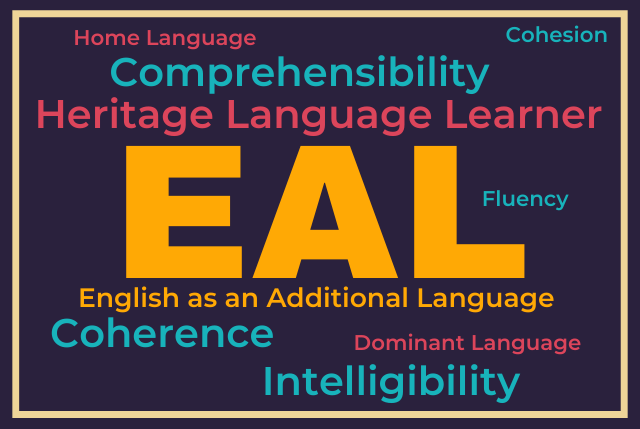In the English Language Institute (ELI), we employ various terms denoting an individual’s language status, and in this post, we will define each one and explain why the ELI has opted to (not) use them.
ESL — English as a Second Language. ‘ESL’ is probably the most widely known term, and that is why the ELI takes advantage of this in terms of communications and outreach. However, the term has lost favor among the language pedagogy community. Why? Because sometimes it is not clear what an individual’s ‘first’ language is (perhaps they grew up speaking one language at home, and a different language at school). And because oftentimes people can speak more than two languages.
EAL — English as an Additional Language. The shortcomings of ‘ESL’ directly translate to the advantages for ‘EAL’ — it is a more inclusive term and applies to a wider range of individuals’ contexts. However, it is not as well known as ‘ESL.’ That is why some of our offerings are labeled as being ‘ESL/EAL.’
A Case Study
As mentioned above, some individuals may not have an easily identifiable ‘first’ language. For example, take a person who starts speaking Spanish at home and then starts attending school in English. English could take over as the individual’s ‘dominant‘ language, even though Spanish was acquired ‘first.’ Let’s say this person continues to communicate at home in Spanish — you could say Spanish is now their ‘home‘ language. Because they’re not getting schooled in Spanish, they might decide to study Spanish formally when they are older. In this case, they would be a ‘heritage language learner‘ of Spanish. Lastly, even though English has become the individual’s dominant language, they might still experience some transfer or interference from Spanish — in this case, the individual could benefit from EAL offerings.
The bottom line is, the ELI recognizes that some of our students might actually be dominant in English. That’s why we think ‘EAL’ covers the most ground as the preferred term.
So, is EAL an adjective?
We do utilize ‘EAL’ as an adjective to describe our offerings, but we avoid using it as an adjective to describe individuals, as most students probably don’t identify as an ‘EAL student.’ But we do utilize the phrases, ‘Students with EAL needs,’ or ‘Students for whom English is an additional language.’
What about ‘native’ and ‘non-native’?
Similarly to ‘ESL,’ we recognize that these terms are very familiar to most people, and therefore we wouldn’t necessarily correct someone for using them. However, given the increasingly complex backgrounds of our students, we don’t feel it is constructive for the ELI to label our students as ‘non-native.’ And, we don’t think it’s constructive for our students to aim to achieve ‘nativeness,’ either. We believe a much more reasonable and attainable goal is to be intelligible, comprehensible, coherent, cohesive, or fluent.
Do you have any other questions? Leave us a comment!

My 5 year old child was recently identified as an EAL student by an interviewing principal for a prep school and this left me quite confused. I had shared with her that my son, Jaden, took a long time to start speaking and I think this was due to the fact that he was exposed to 2 languages while growing up. As a 3 year old, he was looked after a Hindi speaking nanny but his parents spoke to him in English at home. As my partner’s first language is Rotuman and mine is Hindi, we both had decided to speak to my child in English. When Jaden did start speaking, he only spoke in English and he does not know any other language. Is he an EAL speaker then?
Hello Neelam, thank you for your question! I think it would be important to know what the principal’s criteria are for determining a student’s EAL status. Technically, if Jaden is only speaking in English, then it doesn’t make sense that he would be labeled as ‘English as an *Additional* Language.’ However, it is possible that his exposure to other languages could be having an effect on his English. On the other hand, it’s also possible that the principal is using some superficial measure, such as an accent. Therefore, I suggest that you follow up with the principal and ask how the EAL determination was made.
Nonsense! I don’t know why there is such a hang up on terminology. Hey, I teach English as a second language and I am going to continue calling it that. Because whatever their first language is, they are learning English as a second language.
I am not offended when I am trying to learn French as a second language. English is my first language, French would be my second language. FSL. What is the big deal here? It’s a big deal to people who make it a big deal.
I would love to go on, but I have lessons to plan and children to teach who are serious about acquiring new skills so they can change the world by taking actions instead of correcting verbiage.
Hi Jonathan, We think there are some advantages to using ‘EAL’ over ‘ESL,’ but thanks for your take!
AGREE with Jonathan.
I think that the most straightforward explanation for the term ‘additional language’ replacing ‘second language’, is that some people have English as their third or fourth language, and therefore, not ‘second language’. How strange that anyone would insist on the ‘second language’ label, when they don’t know how many languages the child has been learning or has been exposed to before English.
ESL is the terminology for learning English in an English speaking country compared to EFL where you live in a non-English speaking country. EALD has been created to be used in schools in English speaking countries and so it can be more literacy focused to help the teacher continue with their primary subject rather than being communicative and less boring for the student….last part is my opinion..